#Old Kingdom Egypt
Explore tagged Tumblr posts
Text

figure of a squatting frog, Late Predynastic Egypt (Naqada IIb-III) or 1st Dynasty (c. 3300-2900 BCE), green and brown granite
currently in the collection of the British Museum, accession no. EA54372
#isaac.txt#art#archaeology#egyptology#old kingdom egypt#predynastic egypt#egyptian archaeology#naqada#frog
64 notes
·
View notes
Text

Unity - Principles of Design (4/10), digital collage
5 notes
·
View notes
Text
hiii i love the Maxims of Ptahhotep!!! i honestly think that if you've read plato and marcus aurelius you should read ptahhotep. i think a lot of the dehumanization of ancient Egyptians comes from the fact that people don't like. actually engage with them as people but as a semi-fantastical Idea incapable of speaking for themselves without some white tiktok conspiracy theorist speaking for them.
Fun fact: the translation "party girl" is just a guess! The word that's being translated (špnt) isn't known to us currently, so translators have to assume the meaning based on the context of the rest of the maxim.
Some other maxims I like (from here):
[1] "Don't let your heart get big because of your knowledge. Take counsel with the ignorant as well as with the scholar. (For) the limits of art are not brought, (and) no artisan is equipped with perfection. Good discourse is more hidden than green stone, yet may be found among the maids at the grindstones.
[6] Do not scheme against people, (for) god punishes accordingly. If a man (nevertheless) says : 'I shall live that way.', he will lack bread for his mouth. If a man says: 'I shall be rich.' He will have to say: 'My cleverness has snared me.' If a man says: 'I will rob someone.', he will, in the end, make a gift to a stranger [be made a slave]! People's schemes do not prevail. God's command is what prevails. Live then in the midst of peace (with what You have), (for) what they give comes by itself.
[21] When You prosper, found your house, love your wife with ardor, fill her belly, clothe her back, ointment is a remedy for her body. Gladden her heart as long as You live. She is a fertile field, useful to her master. Do not contend with her in a court of justice, (and) keep her from power, restrain her. Her eye is her storm when she gazes. You will make her stay in your house. If You push her back, see the tears! Her vagina is one of her forms of action. What she enforces, is that a canal be made for her.
Another fun fact: There's a 1906 translation of the maxims that censors any maxims that reference sexuality. In maxim 21, it talks about the woman enforcing that a "canal be made for her" referring to being penetrated, essentially that your wife will demand sex from you as a part of a healthy marriage. And they just cut off the ending. In maxim 32, which cautions against sex with children (whether it's referring to pederasty or young girls is debated), they just completely removed it.
if anyone's interested in more information on the gender relations of ancient Egypt & women's lives, I really like Women In Ancient Egypt: Revisiting Power, Agency, And Autonomy edited by Mariam F. Ayad. Reading that helped me realize how much translator bias can change how a text is read. For example, here's another translation of maxim 37:
If you take to wife one who is silly and frivolous, Of light-hearted disposition, and known to her townsmen, She may continue in her ways when at any moment it strikes her fancy. Do not send her away, but allow her to eat (from your table). A light-hearted woman / (at least) provides amusement.
"Špnt" is translated as "frivolous" and "joyfulness marks calm waters" is translated much more dismissively. Similarly, that book talks about how records that potentially show women in the role of scribes have been suggested to mean they were makeup artists. Even without saying which view is right, it shows how the assumption of misogyny limits what we view as possible or likely.
can anyone find me that mesopotamian clay tablet telling you to marry a party girl because she'll bring you joy
31K notes
·
View notes
Text
I was just listening to a podcast about this and I thought it was quite interesting! And it's a fairly "recent" find!
#AncientEgypt#history#archaeology#ancient history#egypt#egyptian history#The Buried Pyramid#Pyramid of Sekhemkhet#arts and culture#unfinished step pyramid#Third Dynasty#Egyptology#Sekhemkhet Djoserty#Old Kingdom Egypt#Early Dynastic Period#step pyramid#Zakaria Goneim#Unas complex#saqqara
1 note
·
View note
Text

Tomb Wall Fragment Depicting Donkeys
Egyptian, Old Kingdom, Dynasty 5 (about 2504–2347 BCE)
This fragment is part of a scene of donkeys being driven over grain to separate wheat from chaff- one that was used in many Egyptian tombs. The tomb’s owner selected the decoration for his or her tomb chamber from a selection of established themes, much as one might select wallpaper today.
663 notes
·
View notes
Text
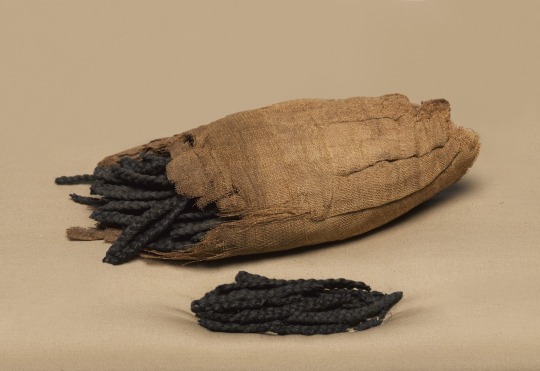
~ Bundle of Hair Extensions.
Date: ca. 2114-1502 B.C.
Period: Old Kingdom-early New Kingdom; 16th-18th Dynasty
Medium: Human hair, linen
▪︎ From the source: These hair extensions would have been placed in a tomb for use in the afterlife. In this world, Egyptians used extensions to make their wigs or natural hair thicker and more attractive, just as people do today. The reliefs in this case show hairdressers adding extensions like these to the hair or wig of Queen Neferu.
#ancient#ancient art#history#museum#archeology#ancient egypt#ancient history#archaeology#egyptian#egyptology#egypt#bundle of hair extensions#extensions#fake hair#queen tiye#old kingdom#new kingdom#16th Dynasty#18th dynasty#human hair#ca. 2114 b.c.#ca. 1502 b.c.
2K notes
·
View notes
Text

Double statue of Hetepheres II embracing her daughter Meresankh III
"The beholder of Horus and Seth, the consort of he who is beloved of the Two Mistresses".
"His daughter, the king's wife, whom he loves".
Old Kingdom, 4th Dynasty, ca. 2490-2472 BC. Tomb G 7530-G 7540, Giza Necropolis. MFA Boston. 30.1456
180 notes
·
View notes
Text
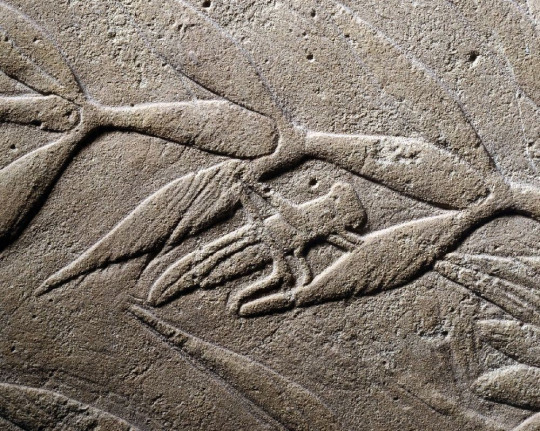
I feel we all need to see the 1,5 cm long grasshopper from the mastaba tomb of Hetepherakhet again
798 notes
·
View notes
Text

4,000-Year-Old Tomb Discovered in Egypt
Archaeologists have discovered the 4,000-year-old ancient Egyptian tomb of "Idi," a local governor's daughter who lived during Egypt's Middle Kingdom (circa 2030 to 1640 B.C.). She was buried within two coffins, one inside the other, representatives of the Egyptian Ministry of Tourism and Antiquities wrote in a statement on Facebook.
"Finding two intact Middle Kingdom coffins is extraordinary," Kathlyn Cooney, a professor of ancient Egyptian art and architecture at UCLA who was not involved with the excavation, said in an email. These coffins "not only seem well preserved but [are] covered with intricate coffin texts that helped the deceased find their way in the realm of the Underworld," Cooney said.
Studying the new coffin texts may provide more information on how the Egyptians viewed the afterlife, said Caroline Arbuckle, an assistant professor of history at the University of Saskatchewan who was not involved with the excavation. "It is always possible that Egyptologists will find new variations, and these help us to better understand what the ancient Egyptians were afraid might stop them from reaching their eternal paradise, or what they felt they might need in the underworld."
Idi lived during the reign of Senwosret I (circa 1961 to 1917 B.C.) and was the daughter of Djefaihapi, the governor of Asyut, one of the richest provinces at the time.
Her tomb was robbed in ancient times, but parts of the skeleton remained. Analysis of those skeletal remains revealed the woman likely died before age 40 and had a congenital defect in one foot.


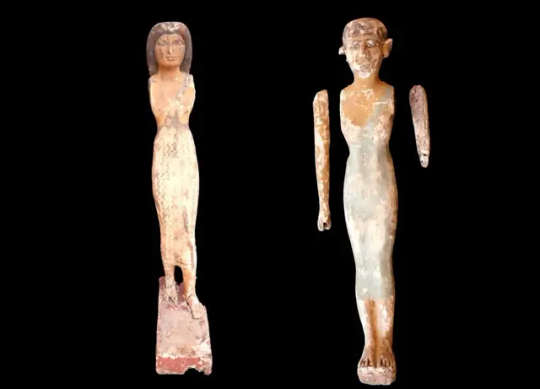
The larger of the two coffins was 8.6 feet (2.6 meters) long, while the smaller one was 7.5 feet long (2.3 m), according to the statement. Archaeologists also found the remains of a coffin lid and wooden figurines.
One of the wooden figurines shows a standing woman who may be Idi. If it is, it would "add to a very limited data set of funerary objects that presumably depict the deceased," Cooney said.
In fact, two figurines may depict Idi, Francesco Tiradritti, an Egyptology professor at the Kore University of Enna in Italy who is not part of the excavation. A second figure may show a woman marching. "I am wondering if that statue does not depict the soul of Idy that is coming out from the tomb," Tiradritti said.

Wolfram Grajetzki, an Egyptologist and honorary senior research fellow at University College London who was not involved in the research, said that the coffin's hieroglyphs call Idi the "lady of the house."
Many tombs and burials have been discovered at Asyut over the past 130 years, and some were found in excavations of dubious legality, he added. Artifacts from those excavations are now in museums around the world.
By Owen Jarus.


#4000-Year-Old Tomb Discovered in Egypt#Burial chamber of 12th dynasty Woman Idi discovered#ancient tomb#ancient grave#ancient burial chamber#Middle Kingdom#ancient artifacts#archeology#archeolgst#history#history news#ancient history#ancient culture#ancient civilizations#ancient egypt#egyptian history#egyptian hieroglyphs
73 notes
·
View notes
Text

I love her your honor
#I gotta look up outfit stuff for her#she's getting a mix of modern and Old Kingdom fashion#anyway here's my mafia boss#strawberry moon#studio#wip#listening to The Prince of Egypt soundtrack and it got me hyped
100 notes
·
View notes
Text

Statue of the lector priest Kaaper, Sheikh el-Balad
Egypt, Old Kingdom, 5th Dynasty, ca. 2494-2345 BC.
Sycamore; the eyes made from alabaster, crystal, and black stone and ringed with copper; Height 112 cm. Mastaba of Kaaper, Saqqara necropolis.
#fine art#artwork#art#ancient egyptian art#ancient egypt#old kingdom#sculpture#carved wood#ancient art#antiquities#antiquity#egyptian art#egyptian history#art history#art of the day#art on tumblr#portraits#portrait#wooden sculpture#egyptology#egypt#archeology
25 notes
·
View notes
Text
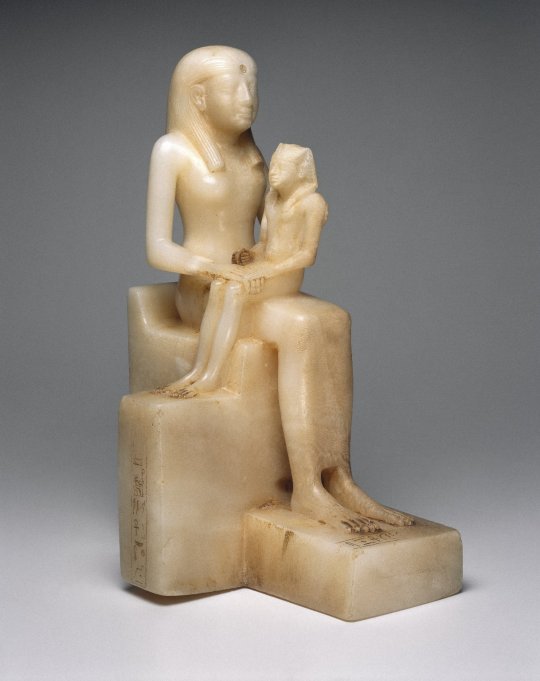
Statue of Queen Anknes-meryre II (Meryreankhne) with Pepy II on her lap (c. Dynasty VI, 2345-2181 BCE); from Upper Egypt; alabaster; each figure has its own hierglyphic inscription
Currently in the collection of the Brooklyn Museum (New York, USA), accession no. 31.119
#isaac.txt#art#archaeology#egypt#egyptian archaeology#egyptology#alabaster#dynasty 6#old kingdom egypt
46 notes
·
View notes
Text
an average standing next to me performance in 25th century BC
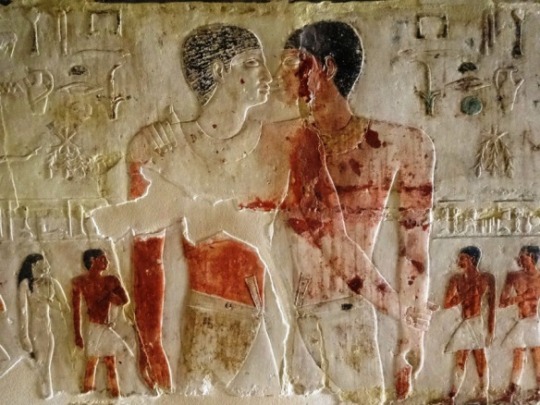
this is a depiction of Niankhkhnum and Khnumhotep, two egyptian men who served under the sixth pharaoh of the fifth dynasty with the title of 'overseer of the manicurists' from their tomb in saqqara, egypt. they are thought to be the oldest depiction of a gay couple in ancient history by some scholars- they were buried together, called 'royal confidants' and shown in poses usually common from married het couples. others, of course, said they were just bros
76 notes
·
View notes
Text
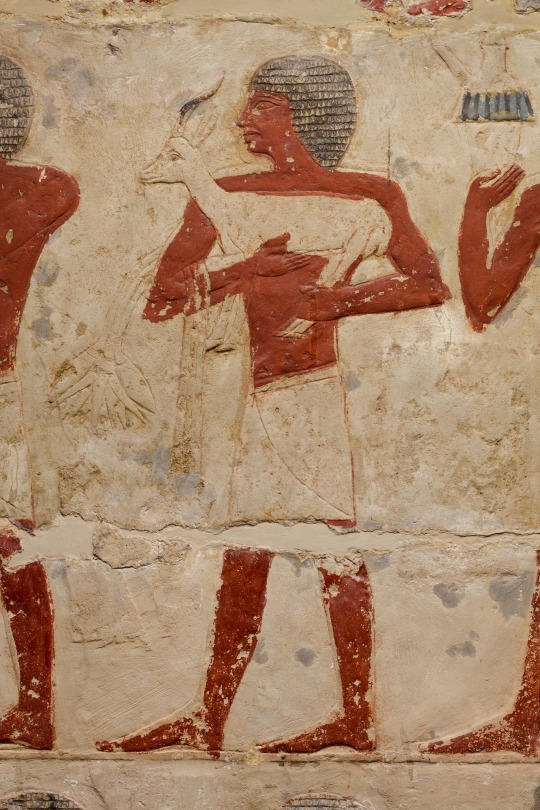
A man brings a gazelle as an offering to the palace administrator Perneb. Scene (painted limestone) from Perneb's tomb at Saqqara, dating to ca. 2381-2323 BCE (5th Dynasty, Old Kingdom). Purchased from the Egyptian government in 1913 and now in the Metropolitan Museum of Art, NYC.
#art#art history#ancient art#Egypt#Ancient Egypt#Egyptian art#Ancient Egyptian art#5th Dynasty#Fifth Dynasty#Old Kingdom#tomb painting#Saqqara#Metropolitan Museum of Art
232 notes
·
View notes
Photo

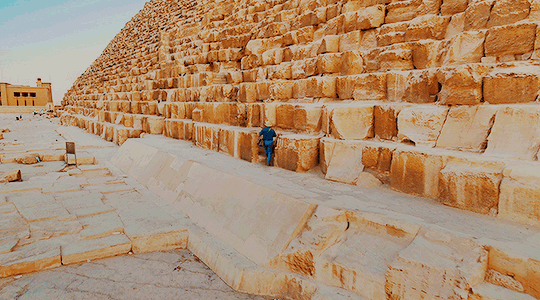
Great Pyramid of Giza: to the bottom center can be seen the original smooth white limestone which would have originally completely covered the inner darker stepped blocks. The inner blocks were quarried in the Giza area while the while higher quality limestone was quarried up river at Tura and had to be transported via the Nile to the pyramid’s location.
#egypt#ancient egypt#egyptology#archaeology#historyedit#mine#my edit#giza#pyramid#the great pyramid#pyramid of khufu#khufu#old kingdom#pyramids
167 notes
·
View notes
Text

The kalasiris is so simple in design, yet so stylish and useful!
𓁐
#history#kalasiris#clothing#ancient egypt#dress#ancient history#egyptology#old kingdom#middle kingdom#new kingdom#art#fashion#soft girl#girly girl#ancient egyptian history#coquette#stylish#ancient egyptian art#womens clothing#historical dress#ancient#egypt#fashion history#ancient egyptian#lenin#nickys facts
10 notes
·
View notes